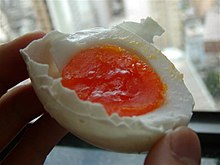Salted duck egg
 |
|
| Place of origin | China, Philippines |
|---|---|
| Main ingredients | Duck Egg in brine |
| |
|
| Salted duck egg | |||||||||||||
| Chinese name | |||||||||||||
|---|---|---|---|---|---|---|---|---|---|---|---|---|---|
| Traditional Chinese | 1. 2. 鹹蛋 |
||||||||||||
| Simplified Chinese | 1. 咸鸭蛋 2. 咸蛋 |
||||||||||||
| Cantonese Yale | 1. hàahm aap daahn 2. hàahm daahn |
||||||||||||
| Hanyu Pinyin | 1. xián yā dàn 2. xián dàn |
||||||||||||
| Literal meaning | 1. salted duck eggs 2. salted eggs |
||||||||||||
|
|||||||||||||
| Alternative Chinese name | |||||||||||||
| Traditional Chinese | |||||||||||||
| Simplified Chinese | 咸蛋 | ||||||||||||
| Literal meaning | salted eggs | ||||||||||||
|
|||||||||||||
| Vietnamese name | |||||||||||||
| Vietnamese | hột vịt muối | ||||||||||||
| Thai name | |||||||||||||
| Thai | ไข่เค็ม (khị khĕm; Literal meaning: salted egg) | ||||||||||||
| Filipino name | |||||||||||||
| Tagalog | itlog na maalat itlog na pula |
||||||||||||
| Transcriptions | |
|---|---|
| Standard Mandarin | |
| Hanyu Pinyin | 1. xián yā dàn 2. xián dàn |
| Yue: Cantonese | |
| Yale Romanization | 1. hàahm aap daahn 2. hàahm daahn |
| Jyutping | 1. haam4 aap3 daan6 2. haam4 daan6 |
| Transcriptions | |
|---|---|
| Southern Min | |
| Hokkien POJ | kiâm-nn̄g |
A salted duck egg is a Chinese preserved food product made by soaking duck eggs in brine, or packing each egg in damp, salted charcoal. In Asian supermarkets, these eggs are sometimes sold covered in a thick layer of salted charcoal paste. The eggs may also be sold with the salted paste removed, wrapped in plastic, and vacuum packed. From the salt curing process, the salted duck eggs have a briny aroma, a gelatin-like egg white and a firm-textured, round yolk that is bright orange-red in color.
Salted duck eggs are normally boiled or steamed before being peeled and eaten as a condiment to congee or cooked with other foods as a flavoring. The egg white has a sharp, salty taste. The orange red yolk is rich, fatty, and less salty. The yolk is prized and is used in Chinese mooncakes to symbolize the moon.
Salted eggs can also be made from chicken eggs, though the taste and texture will be somewhat different, and the egg yolk will be less rich.
Salted eggs sold in the Philippines undergo a similar curing process, with some variation in ingredients used. They are dyed red to distinguish them from fresh duck eggs.
A popular method for processing salted eggs in the Philippines is the Pateros method. The salted egg is prepared "Pateros style" by mixing clay (from ant hills or termite mounds), table salt and water in the ratio of 1:1:2 until the admixture becomes smooth and forms a thick texture similar to cake batter. The fresh eggs are individually dipped in the admixture, and packed in 150-egg batches in newspaper-lined 10x12x18 inch wooden boxes (often residual boxes of dried fish packing). The whole batch is then lightly wrapped in newspapers to slow down the dehydration process.
The eggs are then stored indoors at room temperature over the next 12 to 14 days to cure, the salt equilibrating in the batch by osmosis. Curing can last up to 18 days, but that results in very long-lasting red eggs that can have a 40-day shelf life, which is largely unnecessary, as the eggs are stocked and replenished biweekly.
...
Wikipedia
